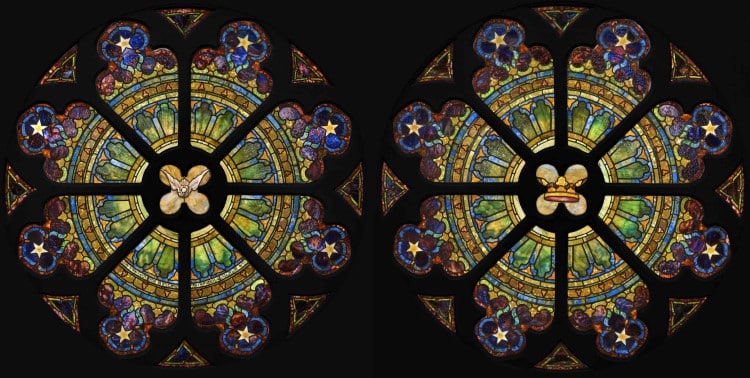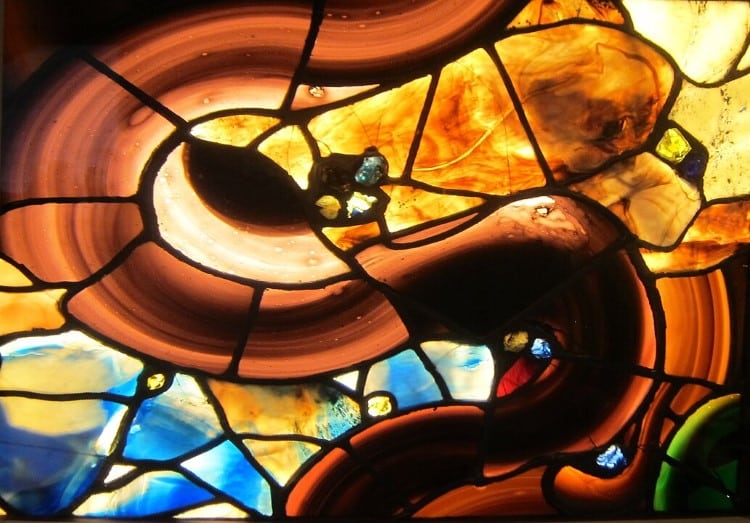
Antique collector Paul Brown is used to looking for interesting collectibles, but he could never have anticipated what he’d find in an old church in Philadelphia. Brown usually deals with old advertising signs and gas station memorabilia, but when he came across two old stained glass windows on Facebook marketplace, his interest was piqued. They were sitting in the Hickman Temple A.M.E. Church, which is currently being converted into the Emmanuel Christian Center.
The Gothic revival church, built in 1901 as the St. Paul’s Presbyterian Church, still held the round windows, which were cracked and covered in grim. Brown was asked if he wanted them before they were “sledgehammered out.” He gladly paid $6,000 for the pair and hired workers to remove the windows from the stone. Brown wasn’t aware that the windows were of particular value but was attracted to them because they were “round and big and they had purple in them.” He figured that their shape, size, and color could bring in buyers.
Once the windows were taken out of the church, Brown brought them to Freeman’s auction house for appraisal and was stunned by what he learned. The twin rose windows he’d purchased were actually created around 1904 by the famed Tiffany Glass and Decorating Company. Opened in 1885 by Louis Comfort Tiffany, they are perhaps most widely known for their stained glass Tiffany lamps.
In fact, Brown was mainly caught off guard by the news because he associated Tiffany with lamps, not windows. However, the firm made a wide range of stained glass items, including vases and windows. These particular windows were likely intended for an expansion of the church. A crown representing Christ sits at the center of one window, while a dove symbolizing the Holy Spirit rests at the center of the second window.

Detail of Bella apartment window by Tiffany Glass and Decorating Company, c. 1880 at the Metropolitan Museum of Art. (Photo: Wmpearl via Wikimedia Commons, Public domain)
“When hit by the light, the layered glass reveals a cross at the center of the dove—an example of Tiffany’s ability to employ his distinct processes to heighten the emotional sensation and deepen the meaning of his designs,” writes the auction house.
After discovering that they were Tiffany windows, Brown invested an additional $50,000 to have them restored. Currently valued at $150,000 to $250,000 each, the pair will go up for sale on May 18 during the Design auction at Freeman’s. Though he can’t be certain that the windows will reach their valuation—or go above it—it’s all but guaranteed that Brown will get a nice return on his investment.
How the Tiffany windows were sold off in the first place makes for another story. The senior pastor at the Emmanuel Christian Center had no clue of their origins and, given their poor condition, told the contractor the sell them. Even a local historical society, which fought to block the church’s renovation, made no mention of Tiffany in their 2021 submission to nominate it for the Philadelphia Register of Historic Places.
The windows were so caked in dirt and mold, that it was most likely quite difficult for experts to see the identifiers of Tiffany glass. Tim Andreadis, the director of decorative arts and design at Freeman’s, told The New York Times that the auction house consulted with several experts before determining that the windows were made by the famed glass studio. They were also able to uncover the name of the church on a list of window patrons published by Tiffany’s in 1910.
Though it’s a shame they are no longer in their original home, it’s certainly wonderful to see the windows get the love and care they deserve, thanks to Brown’s eye for antiques.
h/t: [Artnet]
Related Articles:
Giant Gold Nugget Worth $160,000 Is Found by Amateur Gold Hunter in Australia
Family Discovers Their TV Room Painting Is a Renaissance Masterpiece Worth $845K
Couple Renovating Their Kitchen Discovers 400-Year-Old Paintings Hidden Underneath
Museum Discovers That Its “Fake” Sword Is Actually an Authentic 3,000-Year-Old Weapon
